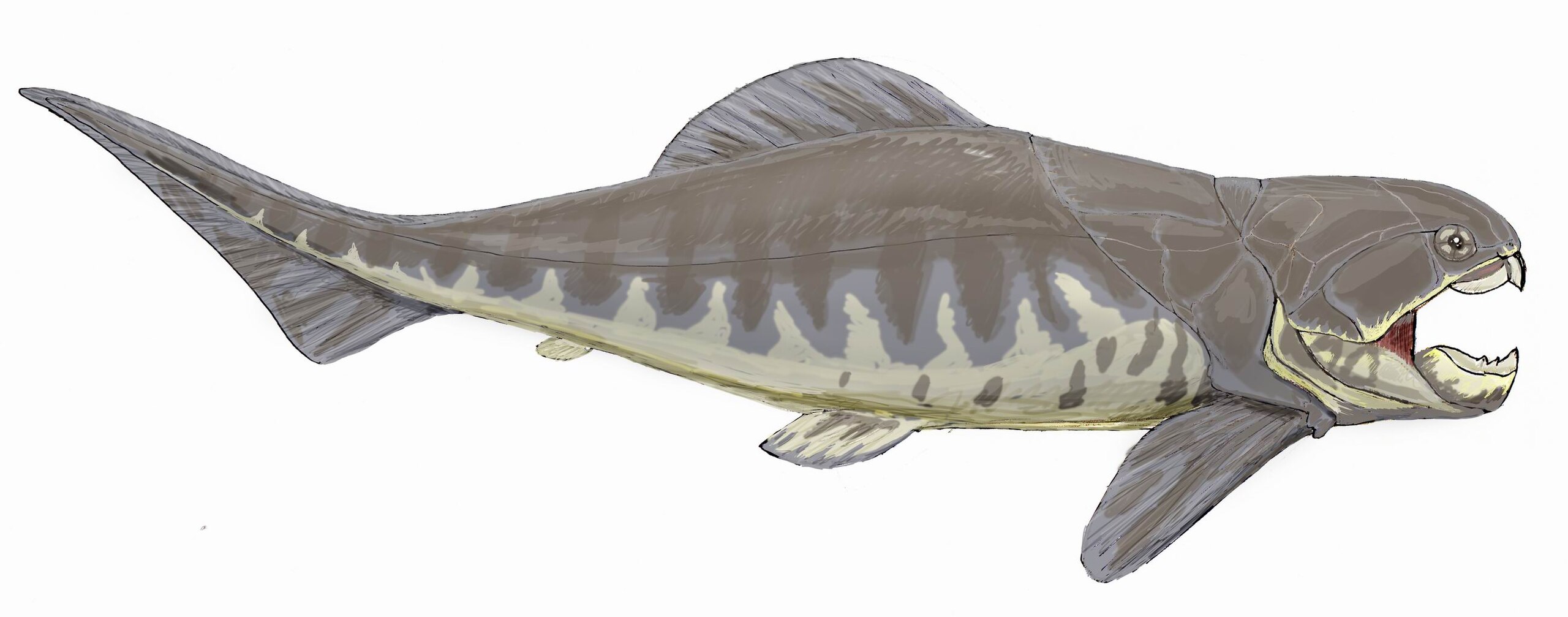Post by dinosauria101 on Aug 22, 2019 10:39:47 GMT 5
Dunkleosteus terrelli
Dunkleosteus is an extinct genus of arthrodire placoderm fish that existed during the Late Devonian period, about 358–382 million years ago. The name Dunkleosteus combines the Greek ὀστέον, osteon, meaning "bone", and Dunkle, in honor of David Dunkle of the Cleveland Museum of Natural History. It consists of ten species: D. terrelli, D. belgicus, D. denisoni, D. marsaisi, D. magnificus, D. missouriensis, D. newberryi, D. amblyodoratus, and D. raveri; some of which are among the largest placoderms to have ever lived. The largest species, D. terrelli grew up to 6 m (19.7 ft) long and 1 t (1.1 short tons) in weight. Few other placoderms rivaled Dunkleosteus in size. Dunkleosteus could quickly open and close its jaw, like modern day suction feeders, and had a bite force of 6,000 N (612 kgf; 1,349 lbf) at the tip and 7,400 N (755 kgf; 1,664 lbf) at the blade edge. Numerous fossils of the various species have been found in North America, Poland, Belgium, and Morocco.

Tylosaurus proriger
Tylosaurus was a mosasaur, a large, predatory marine lizard closely related to modern monitor lizards and to snakes. Along with plesiosaurs, sharks, fish, and other genera of mosasaurs, it was a dominant predator of the Western Interior Seaway during the Late Cretaceous. Tylosaurus proriger was among the largest of all the mosasaurs (along with Hainosaurus and Mosasaurus hoffmannii), reaching maximum lengths of 14 m (46 ft). A distinguishing characteristic of Tylosaurus is its elongated, cylindrical premaxilla (snout) from which it takes its name and which may have been used to ram and stun prey and also in intraspecific combat. Stomach contents associated with specimens of Tylosaurus proriger indicate that this ferocious mosasaur had a varied diet, including fish, sharks, smaller mosasaurs, plesiosaurs, and flightless diving birds such as Hesperornis. In some paleoenvironments, Tylosaurus seems to have preferred shallow, nearshore waters (as with the Eutaw Formation and Mooreville Chalk Formation of Alabama), while favoring deeper water farther out from shore in other environments (as with the Niobrara Chalk of the western U.S.).

Credit to Wikipedia for the text and Dimitri Bogdanov in particular for the images
Dunkleosteus is an extinct genus of arthrodire placoderm fish that existed during the Late Devonian period, about 358–382 million years ago. The name Dunkleosteus combines the Greek ὀστέον, osteon, meaning "bone", and Dunkle, in honor of David Dunkle of the Cleveland Museum of Natural History. It consists of ten species: D. terrelli, D. belgicus, D. denisoni, D. marsaisi, D. magnificus, D. missouriensis, D. newberryi, D. amblyodoratus, and D. raveri; some of which are among the largest placoderms to have ever lived. The largest species, D. terrelli grew up to 6 m (19.7 ft) long and 1 t (1.1 short tons) in weight. Few other placoderms rivaled Dunkleosteus in size. Dunkleosteus could quickly open and close its jaw, like modern day suction feeders, and had a bite force of 6,000 N (612 kgf; 1,349 lbf) at the tip and 7,400 N (755 kgf; 1,664 lbf) at the blade edge. Numerous fossils of the various species have been found in North America, Poland, Belgium, and Morocco.

Tylosaurus proriger
Tylosaurus was a mosasaur, a large, predatory marine lizard closely related to modern monitor lizards and to snakes. Along with plesiosaurs, sharks, fish, and other genera of mosasaurs, it was a dominant predator of the Western Interior Seaway during the Late Cretaceous. Tylosaurus proriger was among the largest of all the mosasaurs (along with Hainosaurus and Mosasaurus hoffmannii), reaching maximum lengths of 14 m (46 ft). A distinguishing characteristic of Tylosaurus is its elongated, cylindrical premaxilla (snout) from which it takes its name and which may have been used to ram and stun prey and also in intraspecific combat. Stomach contents associated with specimens of Tylosaurus proriger indicate that this ferocious mosasaur had a varied diet, including fish, sharks, smaller mosasaurs, plesiosaurs, and flightless diving birds such as Hesperornis. In some paleoenvironments, Tylosaurus seems to have preferred shallow, nearshore waters (as with the Eutaw Formation and Mooreville Chalk Formation of Alabama), while favoring deeper water farther out from shore in other environments (as with the Niobrara Chalk of the western U.S.).

Credit to Wikipedia for the text and Dimitri Bogdanov in particular for the images



